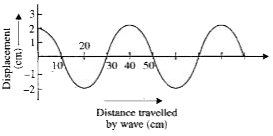For the same objective, the ratio of least separation between two points to be distiguised by a microscope for light of 5000Å and electrons acclerated through 100V used as illuminating substance is __________ (neraly)
2×10−4
2×10−3
2×10−2
4×10−4
The correct Answer is:A
To solve the problem of finding the ratio of the least separation between two points to be distinguished by a microscope for light of wavelength 5000Å and electrons accelerated through 100V, we will follow these steps:
Step 1: Understand the relationship between wavelength and minimum separation
The minimum separation (Δx) that can be distinguished by a microscope is directly proportional to the wavelength (λ). Therefore, we can write:
Δx∝λ
Step 2: Identify the wavelengths
1. For light: The wavelength (λ1) is given as:
λ1=5000Å=5000×10−10m=5×10−7m
2. For electrons: We need to calculate the de Broglie wavelength (λ2) of electrons accelerated through 100V. The formula for the de Broglie wavelength is:
λ=hp
where p is the momentum of the electron. The momentum can be expressed as:
p=mv=√2m⋅KE
where KE (kinetic energy) is given by:
KE=eV
Here, e is the charge of the electron and V is the accelerating voltage.
Step 3: Calculate the de Broglie wavelength for electrons
Using the known values:
- Charge of electron, e≈1.6×10−19C
- Mass of electron, m≈9.11×10−31kg
- Voltage, V=100V
The kinetic energy KE is:
KE=eV=(1.6×10−19C)(100V)=1.6×10−17J
Now, substituting into the momentum equation:
p=√2m⋅KE=√2⋅(9.11×10−31kg)⋅(1.6×10−17J)
Calculating this gives:
p≈√2.91×10−47≈5.39×10−24kg m/s
Now, substituting p into the de Broglie wavelength formula:
λ2=hp=6.63×10−34Js5.39×10−24kg m/s≈1.23×10−10m=1.23Å
Step 4: Calculate the ratio of least separations
Now we have:
- λ1=5000Å
- λ2≈1.23Å
The ratio of the least separations is given by:
Δx1Δx2=λ1λ2
Substituting the values:
Δx1Δx2=5000Å1.23Å≈4065.04
Step 5: Final ratio
The final ratio of least separation between two points to be distinguished by a microscope for light and electrons is approximately:
Δx2:Δx1≈1:4065
Final Answer
The ratio of least separation is nearly 2×10−4.
The minimum separation (Δx) that can be distinguished by a microscope is directly proportional to the wavelength (λ). Therefore, we can write:
Δx∝λ
1. For light: The wavelength (λ1) is given as:
λ1=5000Å=5000×10−10m=5×10−7m
2. For electrons: We need to calculate the de Broglie wavelength (λ2) of electrons accelerated through 100V. The formula for the de Broglie wavelength is:
λ=hp
where p is the momentum of the electron. The momentum can be expressed as:
p=mv=√2m⋅KE
where KE (kinetic energy) is given by:
KE=eV
Here, e is the charge of the electron and V is the accelerating voltage.
Using the known values:
- Charge of electron, e≈1.6×10−19C
- Mass of electron, m≈9.11×10−31kg
- Voltage, V=100V
KE=eV=(1.6×10−19C)(100V)=1.6×10−17J
p=√2m⋅KE=√2⋅(9.11×10−31kg)⋅(1.6×10−17J)
Calculating this gives:
p≈√2.91×10−47≈5.39×10−24kg m/s
λ2=hp=6.63×10−34Js5.39×10−24kg m/s≈1.23×10−10m=1.23Å
Now we have:
- λ1=5000Å
- λ2≈1.23Å
Δx1Δx2=λ1λ2
Substituting the values:
Δx1Δx2=5000Å1.23Å≈4065.04
The final ratio of least separation between two points to be distinguished by a microscope for light and electrons is approximately:
Δx2:Δx1≈1:4065
The ratio of least separation is nearly 2×10−4.
Similar Questions
For the same objective, the ratio of least separation between two points to be distinguished by a microscope for light of 5000Å and electrons accelerated through 100V used as illuminating substance is __________ (nearly)
View SolutionThe diameter of human eye lens is 2mm. What should be the minimum separation between two points situated at 50m from eye, to resolve tham. Take wavelength of light =5000Å.
View Solution
Knowledge Check
For the same objective, what is the ratio of the least separation between two points to be distinguished by a microscope for light of 5000 Ã… and electrons accelerated through 100 V used as an illuminating substance?
A3075B3575C4075D5075Two points separated by a distance of 0.1mm can just be resolved in a microscope when a light of wavelength 6000Å is used. If the light of wavelength 4800Å is used this limit of resolution becomes
A0.8 mmB0.12 mmC0.1 mmD0.08 mm
The diameter of human eye lens is 2mm. What should be the minimum separation between two points situated at 50m from eye, to resolve tham. Take wavelength of light =5000Å.
View SolutionThe value of numerical aperature of the objective lens of a microscope is 1.25 if light of wavelength 5000 Å is used the minimum separation between two points to be seen as distinct, will be
View SolutionThe heat of neutralization for a strong acid by a strong base is a constant
View SolutionA wave travelling along the length of a string is shown in Fig. 14.4.12. Using the scale on the given axis, find
(i) The amplitude of the wave
(ii) The wavelength of the wave
(iii) If the frequency of the wave is 10 Hz, What is the speed of the wave?
(iv) What is the initial phase of the wave ?
(v) What is the phase difference between two points separated by a distance 10 cm ?
(vi) If this wave is made to travel through water what is the wavelength of the wave, if the speed of, the waves in water is 10 m/s.

View SolutionIn a YDSE, distance between the slits and the screen is 1m, separation between the slits is 1mm and the wavelength of the light used is 5000nm. The distance of 100th maxima from the central maxima is:
View SolutionTwo coaxial plane coils, each of n turns of radius a, are separated by a distance a. calcualte the magnetic field on the axis at the point midway between them when a current l flows in the same sense through each coil.
Electrons in a colou television tube are accelerated through a potential difference of 25 kV and then deflected by 45∘ in the magnetic field between the two coils described above. If a is 100 mm and the maximum current available for the coils is 2A, estimate the number of turns which the coils must have.
View Solution
